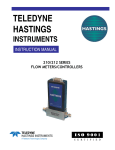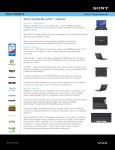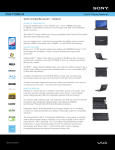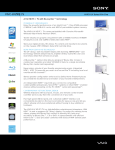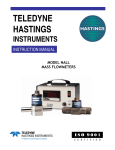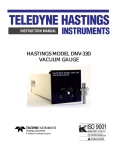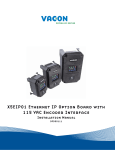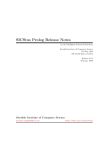Download Teledyne HFM-60 Automobile Parts User Manual
Transcript
TELEDYNE HASTINGS INSTRUCTION INSTRUCTION MANUAL INSTRUMENTS MODEL HFM-60 FLOWMETER page 1 Manual Print History The print history shown below lists the printing dates of all revisions and addenda created for this manual. The revision level letter increases alphabetically as the manual undergoes subsequent updates. Addenda, which are released between revisions, contain important change information that the user should incorporate immediately into the manual. Addenda are numbered sequentially. When a new revision is created, all addenda associated with the previous revision of the manual are incorporated into the new revision of the manual. Each new revision includes a revised copy of this print history page. Revision A (Document Number 143-042000) ................................................................ April 2000 Revision B (Document Number 143-102002) .......................................................... October 2002 Revision C (Document Number 143-082005) ............................................................ August 2005 Visit www.teledyne-hi.com for WEEE disposal guidance. Hastings Instruments reserves the right to change or modify the design of its equipment without any obligation to provide notification of change or intent to change. page 2 Table of Contents 1 . 0 GENERAL INFORMA TION ............................................................. 5 INFORMATION 1.1 Features ............................................................................................................................... 5 1.2 Specifications ....................................................................................................................... 6 1.3 Optional 4-20 mA Current Output ...................................................................................... 7 1.4 Digital Display (900 tiltable) ................................................................................................. 7 1.5 Wall Transformer Power Supply ........................................................................................... 7 1.6 Other Accessories ................................................................................................................. 7 2 . 0 INST ALLA TION .................................................................................. 9 INSTALLA ALLATION 2.1 Receiving Inspection ............................................................................................................ 9 2.2 Power Requirements ............................................................................................................. 9 2.3 Output Signal ....................................................................................................................... 9 2.4 Mechanical Connections ....................................................................................................... 9 2.5 Electrical Connections ........................................................................................................ 10 2.6 Operation ........................................................................................................................... 11 3 . 0 THEOR Y OF OPERA TION ............................................................. 1 3 THEORY OPERATION 3.1 Overall Functional Description ........................................................................................... 13 3.2 Sensor ................................................................................................................................ 13 3.3 Base ................................................................................................................................... 14 3.4 Shunt ................................................................................................................................. 14 3.5 Electronic Circuitry ........................................................................................................... 16 4 . 0 MAINTENANCE ................................................................................ 1 7 4.1 Authorized Maintenance ..................................................................................................... 17 4.2 Troubleshooting ................................................................................................................. 17 4.3 Adjustments ....................................................................................................................... 18 4.4 End Cap Removal .............................................................................................................. 19 4.5 Printed Circuit Board Replacement .................................................................................... 20 4.6 Sensor Replacement ........................................................................................................... 20 5 . 0 WARRANTY AND REP AIR ............................................................. 2 1 REPAIR 5.1 Warranty Policy .................................................................................................................. 21 5.2 Non-Warranty Repair Policy .............................................................................................. 21 6 . 0 DIA GRAMS AND DRA WINGS ...................................................... 2 3 DIAGRAMS DRAWINGS page 3 page 4 SECTION 1 General Information The Hastings Mass Flowmeter, HFM-60 is designed to accurately measure mass flow up to 70 slpm with an accuracy of better than 3%. Hastings mass flow instruments do not require any periodic maintenance under normal operating conditions with clean gases. No damage will occur from the use of moderate overpressures (~150 psi) or overflows. Calibrations for other gases, such as oxygen, helium and argon, are available upon special order. Instruments are normally calibrated with the appropriate standard calibration gas (nitrogen) then a correction factor is used to adjust the output for the intended gas. 1.1 Features • • • • • • • • • • The HFM-60 is intrinsically linear. Should recalibration (a calibration standard is required) in the field be desired, the customer needs to simply set the zero and span points. The HFM-60 incorporates a removable/replaceable main PC board/sensor module which virtually eliminates long down time due to clogging. Clogging is the most common cause of failure in the industry. The HFM-60 sensor is less likely to be clogged due to the large internal diameter (0.020”). Each flowmeter has a shunt which can be quickly and easily exchanged in the field to different ranges. Calibration, however, is required. The filters located upstream of the shunt and sensor eliminate most of the larger particulates and impurities which tend to clog the sensor tube. The HFM-60 is available in ranges from 0-10 sccm to 0-60 slpm (air equivalent flow). Special ranges are available upon request. The HFM-60 is constructed of 6061-T6 aluminum alloy. Buna-N is standard for the O-rings and seals. Other elastomers are available upon request, e.g., Kalrez,Viton. The temperature coefficient of the HFM-60 is less than 0.1%/°C from 0-50°C. The 4-20 mA option gives the user the advantages of a current loop output to minimize environmental noise pickup. The optional 0-90° tiltable digital display allows convenient real time indication of the flow rate. The low pressure drop across this instrument is ideal for leak detection applications. page 5 1.2 Specifications Accuracy ......................................................................................................................... <±3% F.S. Repeatability ................................................................................................. ±0.2% of F.S.(typical) ±0.4% of F.S. (max.) Maximum pressure ............................................................................................................. 150 psi. Pressure coefficient ................................................................................................... 0.01%/psi (N2) Operating temperature ............................................................................ 0-50°C in non-condensing environment Temperature coefficient (zero) ..................................................................... ±1000 ppm/°C, typical (±2000 ppm/°C, max) Temperature coefficient (span) ....................................................................... ±500 ppm/°C, typical (±1000 ppm/°C, max) Leak integrity ........................................................................................................... 1x10-9 std. cc/s. Standard Flow ranges ...................................................................... 10, 20, 50, 100, 200, 500 sccm. 1, 2, 5, 10, 20, 40, 70 slpm. Standard Output .............................................................................................................. 0-5 VDC. Optional Output .............................................................................................................. 4 -20 mA. Power ...................................................................... +15 to +25VDC, ≤60 mA (0 - 5VDC output). +15 to +25VDC, ≤80 mA (4-20 mA output). Wetted Materials ...................................................................... 6061 Al, 304L stainless steel, nylon, Buna N, Monel 400, Pb40Sn solder, (Cu30Zn brass in 40 to 60 slpm units, and epoxy in 10 to 200 sccm units) page 6 1.3 Optional 4-20 mA Current Output An option to the standard 0-5 VDC output is the 4-20 mA current output that is proportional to flow. The 4 - 20 mA signal is produced from the 0 - 5 VDC output of the flowmeter. The current loop output is useful for remote applications where pickup noise could substantially affect the stability of the voltage output. The load impedance should be between 0 and 400 Ω. 1.4 Digital Display (0-90° Tiltable) 1.4.1 Local Display For real time indication of the flow rate, a very useful option available is a 3.5 digit LCD digital display module mounted directly on top of the flowmeter case. The display can be rotated 90° from the horizontal position to the fully vertical for better visibility. The LCD digits are large and clear and can be easily discerned at distances of 20 feet. 1.4.2 Remote Display The tiltable display module may be removed from the flowmeter case and mounted at any distance away from the flowmeter body to permit convenient observation. Standard lengths of 7', 15' and 25' cable (also special orders of any desired length) are available. 1.5 Wall Transformer Power Supply The input voltage required for operation of the flowmeter is +15 to +25 VDC, at a maximum of 60 mA (80 mA for the 4-20 mA output option). A 115 VAC wall power supply rectified to +18.5 VDC is available as a power supply option. The wall power supply comes with a 6' length of 2 conductor cable which can be connected directly to the HFM-60 connector. 1.6 Other Accessories 1.6.1 Totalizer (ATR-1J) The Hastings Flow Totalizer integrates the 0-5 VDC signal generated by the flowmeter to give a total flow reading. Count rates from 0 to 999 counts per minute are selectable by internal setting. 1.6.2 Hastings Model 400/200/40/10 Power Supply Hastings power supplies (other than the aforementioned wall transformer) are available in either one, two or four channel versions. They convert 115 or 230VAC to the +15 VDC required to operate the flowmeter. Interface terminals for the +15 VDC input and the 0-5 VDC linear output signal are located on the rear of the panel. Also, a cable can be supplied with the power supply that provides the +15 VDC on pin 11 of a “D” connector and the 0 - 5VDC output measurement on pin 6. Pins 5 and 12 are common and pin 7 is chassis ground. Throughout this manual, when reference is made to a power supply, it is assumed the customer is using a Hastings wall power supply or a Model 200/400/40/10 supply. page 7 page 8 SECTION 2 Installation This section contains the necessary steps to assist in getting a new flowmeter in operation as quickly and easily as possible. Please read the following thoroughly before attempting to install the instrument. WARNING The customer should determine if their process gas is compatible with the wetted materials of the flowmeter as specified in section 1.2. Some corrosive gases may damage the flowmeter materials and elastomer corrosivegases ing. This could result in incor rect flo w measurement, or leakage o ver O-r incorrect flow ov O-ring. time. 2.1 Receiving and Inspection Carefully unpack the Hastings HFM-60 and any accessories that have also been ordered. Inspect for any obvious signs of damage to the shipment. Immediately advise the carrier who delivered the shipment if any damage is suspected. Check each component shipped with the packing list. Insure that all parts are present (i.e., flowmeter, wall transformer power supply, cables, etc.). Optional equipment or accessories will be listed separately on the packing list. There may also be one or more OPT-options on the packing list. These normally refer to special ranges or special gas calibrations. They may also refer to special helium leak tests, high pressure tests or special modifications such as high temperature O-ring materials. In most cases, these are not separate parts, but special options or modifications built into the flowmeter. 2.2 Power Requirements The HFM-60 requires +15 to+25VDC, 60mA (0 - 5VDC output); 80mA (4 -20mA output). The supply voltage should be regulated such that there is no more than 50 mV ripple. Surge suppressors are recommended to prevent power spikes reaching the instrument. These power requirements are satisfied by the Hastings wall transformer or by the Hastings wall power supply described in Section 1.6.1 or 1.6.2. 2.3 Output Signal The standard output of the flowmeter is a 0-5 VDC signal proportional to the flow rate. The input power is applied at pins 1 (+15 to+25 VDC) and 2 (ground). The output is obtained on pins 3 (0 to +5 VDC) and 4 (common) of the 4 pin connector. It is recommended that the load resistance be no less that 2 kΩ. When the 4-20 mA option (see Section 1.3) is selected the output is also on pins 3 and 4. The load impedance must be no greater than 400 Ω. 2.4 Mechanical Connections The flowmeter may be mounted in any position as long as the direction of gas flow through the instrument follows the arrow marked on the bottom of the flowmeter case label. The preferred orientation is with the inlet and outlet fittings in a horizontal plane. Changing the mounting orientation requires re-zeroing of the instrument at zero flow. The smallest of the internal passageways in the HFM-60 is the diameter of the sensor tube, which is 0.020 and the annular clearance for the 500 sccm shunt which is 0.009", so the instrument requires adequate filtering of the gas supply to prevent blockage or clogging of the tube. The screen diffusers assist in filtering to some extent where the filter mesh is as small as 0.010". page 9 There is a threaded hole in the bottom of the transducer that can be used to secure it to a mounting bracket, if desired. Other holes for special mounting can be added to the end cap as desired. The standard inlet and outlet fittings for the HFM-60 are 1/4" NPT to 1/4" Swagelok (optional VCR and VCO fittings are available from the factory). The O-rings for the end cap and the sensor are Buna N (optional Kalrez, Neoprene or Viton O-rings are available from the factory). It is suggested that all connections be checked for leaks after installation. This can be done by pressurizing the instrument (do not exceed 150 psig unless the flowmeter is specifically rated for higher pressures) and applying a diluted soap solution to the flow connections. 2.5 Electrical Connections If a wall transformer power supply from Hastings Instruments is used, installation consists of connecting the 4 conductor cable to the 4 pin connector located on the side of the flowmeter. The power is supplied to the instrument on pin 1, +15 to +25VDC, and pin 2, ground. The output is measured on pin 3, 0 - 5 VDC or 4-20 mA and pin 4, ground. If a Hastings Model 400/200/40/10 power supply is used, installation consists of connecting a 4 conductor cable to the terminal strip on the rear of the supply to the 4 pin connector located on the side of the flowmeter (similar to that described above). Also, a cable with a male “D” connector can be supplied that mates with the power supply. The “D” connector cable provides +15 VDC on pin 11 and the 0-5 VDC output on pin 6. Pins 5 and 12 are common and pin 7 is chassis ground. 2.6 Operation The standard instrument output is a 0 - 5 VDC out and the signal is proportional to the flow i.e., 0 volts = zero flow and 5 volts = 100% of rated flow. The low noise 4 - 20 mA option is also proportional to flow (4 mA = zero flow and 20 mA = 100% of rated flow). 2.6.1 Operating Temperature For proper operation, the combination of ambient temperature and gas temperature must be such that the flowmeter temperature remains between 0 and 50°C. Most accurate measurement of flow will be obtained if the flowmeter is zeroed at operating temperature as temperature shifts result in some zero offset. 2.6.2 Zero Check Connect the wall transformer power supply to the instrument or if using a Hastings power supply, turn the power supply on. Allow approximately 10% flow for 1/2 hour warm-up. Stop all flow through the instrument and wait 2 minutes. Caution: Do not assume that all metering valves completely shut off the flow. Even a slight leakage will cause an indication on the meter and an apparent zero shift. For the standard 0-5 VDC output, adjust the zero potentiometer located on the lower outlet side of the flowmeter until the meter indicates zero. For the optional 4-20 mA output, adjust the zero potentiometer so that the meter indicates slightly more than 4 mA, i.e. 4.03 to 4.05 mA. This slight positive adjustment ensures that the 4-20 mA current loop transmitter is not in its cut-off region. The error induced by this adjustment is approximatly 0.3% of full scale. This zero should be checked periodically during normal operation. Zero adjustment is required if there is a change in ambient temperature, vertical orientation of the flowmeter, or a change in input voltage. 2.6.3 Blending of Gases page 10 If more than one flowmeter is used to mix gases and each is calibrated for a given gas, a desired mixture of the gases can be achieved. As an example, suppose a total flow rate of 50 slpm of gases A+B+C is required; 15% of the total flow should be gas B, 20% of the total flow should be gas C and the balance is gas A. Then gas A should have a total flow of 0.65 (50) = 32.5 splm, gas B should have a total flow of 0.15(50) = 7.5 splm and gas C should have a total flow of 0.20(50) = 10 splm. Further, let us say that flowmeter A has a 0-60 slpm range, flowmeter B has a 10 slpm range and flowmeter C has a 40 slpm range. Since all 3 flowmeters have 0-5 VDC out then flowmeter A should be set to read 5/60 = A/32.5 or A = 2.71volts, flowmeter B should be set to read5/10 = B/7.5 or B = 3.75 volts and flowmeter C should be set to read 5/40 = C/10 or C = 1.25 volt. Ideally, however, flow controllers are a far better way to accomplish the blending, simply because there are no problems with pressure fluctuations. 2.6.4 Range Changes: The range of the flowmeter can be changed in the field if recalibration facilities are available. The flowmeter may require a different shunt which can be purchased from the factory. A listing of available shunts (order codes) and the corresponding air equivalent flow ranges are as follows: Order Code Shunt Range Order Code Shunt Range 01 0-10 sccm 07 0-1 slpm 02 0-20 sccm 08 0-2 slpm 03 0-50 sccm 09 0-5 slpm 04 0-100 sccm 10 0-10 slpm 05 0-200 sccm 11 0-20 slpm 06 0-500 sccm 12 0-40 slpm 13 0-70 slpm Gases other than air or nitrogen have different properties, and the range of each shunt will be different than those listed in the order codes above. The flow rate of interest determines the size of the shunt required. As previously indicated, 13 separate shunts are required for the range of flow spanning 10 sccm to 70 slpm full scale. For the 200 sccm flow range, four Monel 400 tubes of 0.027" i.d. are located within the aluminum shunt plug to accommodate the full 200 sccm. Lower flow rates require proportionally fewer tubes and the unused holes are sealed with epoxy (or selected eutectic solder if epoxy is undesired). A single 304L stainless steel plug with an annular spacing of 0.009" with the base accommodates the 500 sccm flow range. Increasing the flow requires more annular passageways which is accomplished by adding concentric cylinder shells with increasing gap dimensions. Eventually, a maximum annular gap dimension for laminar flow is obtained (~0.030"). For a maximum flow rate of 60 slpm, three annular regions using two brass concentric cylinders is required. To change ranges, a new shunt must be installed and a calibration conducted to do further measurements. 2.6.5 Spanning the Digital Display An exchange of shunt requires resetting of the digital display. Ideally, the flow should be established to the full scale level consistent with the selected shunt and the display pot adjusted for that full scale flow rate. It is also possible to disconnect the phone jack connector to the main body and input 5.00VDC and set the display consistent with the particular full scale flow for the selected shunt. Verify the full scale voltage/current output and adjust the display pot for that full scale flow rate. It is also possible to disconnect the phone jack between the display and flowmeter, and supply external power (+5 VDC) and a full scale voltage (0-5 VDC) to the display. Refer to the schematics of PCB-846 in section 6 of this manual. The display may then be adjusted consistent with the particular full scale flow for the selected shunt. Note that there may be need to change the display board solder jumpers in order to exhibit the new full scale flow rate. Largest Displa y Value Display Jumper Setting 1999. All jumpers open 199.9 JP 1 closed 19.99 JP 2 closed 1.999 JP 3 closed page 11 page 12 SECTION 3 Theory of Operation This section contains an overall functional description of the HFM-60. Detailed schematics and parts lists can be found at the end of the manual in Section 5.0. In this section and other sections throughout this manual, it is assumed that the customer is using the wall transformer power supply supplied by Hastings or a Hastings Power Supply. 3.1 Overall Functional Description The HFM-60 consists of a sensor, a base, shunt and electronic circuitry. The sensor measures the gas flow rate from 0 to 10 sccm. The shunt divides the flow such that the flow through the sensor is a precise percentage of the flow through the shunt. The flow through both the sensor and shunt is laminar. The circuit board amplifies the sensor output from the two Chromel P thermocouples and and provides an analog output of either 0-5 VDC or 4-20 mA. The output can also be indicated on the digital display. 3.2 Sensor The Hastings HFM-60 operates on a unique thermal electric principle whereby a metallic capillary tube is heated uniformly by a resistance winding attached at the center of the capillary (see figure 3.1). Thermocouples TC-1 and TC-2 are positioned on each side of the heater coil and are welded at equal distances from the mid-point of the capillary. At zero flow, the TC outputs are equal. When flow occurs through the tubing, heat is transferred from the heated region to the gas and from the gas back to the cool wall downstream. Thermocouple TC-1 measures the temperature upstream before the gas is heated and thermocouple TC-2 measures the gas temperature downstream after it is heated. During flow, the temperature distribution along the sensor tube becomes skewed (see figure 3.2). Conventionally, the difference in temperature of the two thermocouples provides a voltage difference that is proportional to flow. Heater (VDC Source) TC-2 TC-1 PC Board O-ring Nylon Spacer flow figure 3.1 For a constant power input, the differential voltage is a function of the mass flow rate and the heat capacity of the gas. Since the heat capacity of many gases is relatively constant over wide ranges of temperature and pressure, the flowmeter may be calibrated directly in mass units for those gases. Changes in gas composition usually require application of a multiplication factor to the air calibration to account for the difference in heat capacity. The flowmeter is capable of measuring a wide range of gases. The Monel 400 sensor tube has an internal diameter of 0.0205" and is heated by 600 W of MWS-800 wire. This diameter allows approximately 10 sccm full scale flow with ∆p of 0.5 inches of H2O. The sensor is encapsulated by a plastic cover and filled with fiberglass insulation to minimize convective heat losses. page 13 Temperature of tube ZERO FLOW SMALL FLOW TC-1 L/2 TC-2 0 L/2 Length of tube figure 3.2 3.3 Base The 6061 aluminum alloy base has a 1" square cross-section and is 3.375" long (with end cap). The internal flow channel is 0.812" diameter with in and out 304L stainless steel fittings 1/4" NPT to 1/4" Swagelok fittings. 3.4 Shunt The flow rate of interest determines the size of the shunt required. As previously indicated, 13 separate shunts are required for the range of flow spanning 10 sccm to 70 slpm full scale. The geometry of the shunt for 0- 200 sccm is shown in figure 3.3(a). Four Monel 400 tubes of 0.027" i.d. are located within the aluminum plug to accommodate the full 200 sccm. Lower flow rates require proportionally fewer tubes and the unused holes are sealed with epoxy (or selected eutectic solder if epoxy is undesired). At the lowest flow rate (10 sccm), the shunt is completely blocked and all of the flow is routed through the sensor. Figure 3.3(b) shows the geometry for higher flow rates. A single 304L stainless steel plug with an annular spacing of 0.009" accommodates the 500 sccm flow range. Increasing the flow requires more annular passageways which is accomplished by adding concentric cylinder shells with increasing gap dimensions. Eventually, a maximum annular gap dimension for laminar flow is obtained (~0.030"). For a maximum flow rate of 70 slpm, three annular regions using two brass concentric cylinders is required. This patent pending shunt technology also includes inboard sensor ports which ensure laminar flow without the turbulence associated with end effects. This unique flow geometry provides an exceedingly linear shunt. A schematic diagram of the integral flowmeter (without the digital display module) employing a 70 slpm shunt is shown in figure 3.4. Note the inboard location of the sensors inlet and outlet with respect to the inlet and outlet of the shunt. Also note the screen disk and washer which are used to minimize the radial velocity gradient entering the shunt. This results in a more uniform flow velocity profile and therefore, more uniform flow in the annular passages of the shunt. page 14 epoxy flow Aluminum 10 sccm - 200 sccm (typical configuration) figure 3.3 (a) annular flow passages flow 500 sccm - 70 slm (typical configuration) figure 3.3 (b) page 15 3.5 Electronic Circuitry The HFM-60 employs a thermal flow sensor (capillary tube described in section 3.2) to measure the flow which is proportional to the total flow through the instrument. The sensor develops a differential voltage output signal proportional to flow which is approximately 1 mV full scale magnitude. A differential amplifier and an inverting amplifier boost the signal strength by a factor of ~5000 at full scale flow. The amplified output can be measured on pins 3 and 4 of the external connector. If a Hastings power supply is employed, the 5 volt output is also sent to the terminals on the back and to the decoding circuitry in the display which converts it to a 3 and 1/2 digit output. An optional 4-20 mA analog output on pins 3 and 4 is also available in lieu of an output voltage. The addition of a 4-20 mA current loop transmitter on the secondary pc board (mounted parallel to the main pc board) is required to provide this current loop. A jumper change is made on the main PC board to establish the selected output mode. The digital display option includes the tiltable LCD display module which is removable for remote display. This separate module contains its own pc board and mounts directly on the top of the main cover. This local or remote digital unit provides a continual digital display in addition to the 0-5 VDC or 4-20 mA output. A standard 4 conductor phone jack and cable is used to connect the display module to the main pc board. The circuit diagrams for the aforementioned functions are presented in Section 6. This section contains service and calibration information. Some portions of the instrument are delicate. Use extreme care when servicing the instrument. The potentiometer positions and the electrical components referred to in the troubleshooting section can be found in Section 4.3 on the electrical component layout drawing. cover PC board flow shunt plug (60 slm shown) end cap O-ring fine screen coarse screen base shunt tubes spacer figure 3.4 page 16 SECTION 4 Maintenance 4.1 Authorized Maintenance With proper care in installation and use, the flowmeter will require little or no maintenance. If maintenance does become necessary, most of the instrument can be cleaned or repaired in the field. Some procedures may require recalibration. Do not attempt these procedures unless facilities are available. Entry into the sensor or tampering with the printed circuit board will void warranty. Do not perform repairs on these assemblies while the unit is still under warranty. 4.2 Troubleshooting Symptom: Output reads strong indication of flow with no flow present. Zero pot has no effect. Cause: Power shorted out. Action: Unplug power supply for a few seconds, then plug it back in. If this is ineffective, disconnect the power supply from the unit and check the power supply voltage (+15 to +25 VDC on pin 1). Symptom: Output of flowmeter is proportional to flow, but extremely small and not correctable by span pot. Cause: Sensor is not being heated. Action: Shut off gas supply and disconnect the power to the flowmeter. Remove cover and pc board from unit. Check the resistance between w1 and w2 on PCB-844 (refer to figures in section 6) of the flowmeter. The resistance should be approximately 560 W. The resistance between w3 and w4 should be approximately 2-3 W. If not, the sensor unit needs to be replaced. Symptom: Sensor has proper resistance readings, but little or no output with flow. Cause: Plugged sensor. Action: Shut off gas supply and disconnect the power to the flowmeter. Remove cover and pc board from unit. If sensor has evidence of clogging, clean or replace as applicable. Symptom: Flowmeter reads other than 0.00 VDC with no flow or there is a small flow when the flowmeter reads 0.00 VDC. Cause: Zero pot is out of adjustment. Action: Shut off all flow. For the standard 0-5VDC output, adjust the zero potentiometer located on the lower outlet side of the flowmeter until the meter indicates zero. For the optional 4-20 mA output, adjust the zero potentiometer so that the meter indicates slightly more than 4 mA, i.e. 4.03 to 4.05 mA. This slight positive adjustment ensures that the 4-20 mA transmitter is not in its cut-off region. The error induced by this adjustment is approximately 0.3% of full scale. Symptom: Flowmeter is out of calibration and non-linear. Cause: Leaks in the gas inlet or outlet fittings. Action: Check all fittings for leaks by placing soap solution on all fittings between gas supply and final destination of gas. Check flowmeter for leaks. Replace “O”-rings if required or recalibrate as necessary. page 17 4.3 Adjustments Calibration Procedure (See figure 4.1) 1. Connect power to pins 1 and 2 as specified in Section 2.5. Allow the instrument to warm up for 30 minutes with 10% flow. 2. Completely shut off the flow and wait for 2 minutes. For the standard 0-5VDC output, adjust the zero potentiometer located on the lower outlet side of the flowmeter until the meter indicates zero. For the optional 4-20 mA output, adjust the zero potentiometer so that the meter indicates slightly more than 4 mA, i.e. 4.03 to 4.05 mA. This slight positive adjustment ensures that the 4-20 mA transmitter is not in its cut-off region. The error induced by this adjustment is approximately 0.3% of full scale. 3. Turn on gas supply to inlet of instrument and insure the flow rate is an accurate maximum flow for the shunt employed. Ensure that the full range can still be obtained at minimum inlet pressure. 4. Adjust Span pot until the flow reference reads full scale (5.00VDC or 20 mA). Perform this step only if a calibrated reference flowmeter is available. 5. Adjust the span pot of the display so that it reads correct full scale flow. 6. Record flowmeter and flow reference outputs for flow rates of 20%, 40%, 60%, 80% and 100% and make sure data are within ± 3% of full scale. flow span zero figure 4.1 page 18 4.4 End Cap Removal The end cap on the inlet side must be removed to gain access to the filter and shunt assembly. First remove power and shut off the supply of gas to the instrument. Disconnect the Swagelok fittings on the inlet and outlet sides of the transducer and remove it from the system plumbing. Remove the two Allen head screws holding the end cap to the instrument (see figure 4.2). Carefully remove the end cap, retaining ring, filter, spacer, filter washer and ball bearing (if present) and shunt, noting their order and proper orientation. The shunt can be severely damaged if dropped. Examine the filter and shunt. If either is damaged, dirty or blocked, clean and replace as applicable. Reassemble in the reverse order of disassembly. Secure the endcap with 4 in lb of torque on each 18-8 stainless steel socket head cap screw. Use of a fastener other than the one mentioned here tion of the HFM-60 is necessar y. may result in leakage at the seal. Recalibra Recalibration necessary 60 slm 40 slm 10 sccm to 200 sccm figure 4.2 page 19 4.5 Printed Circuit Board Replacement In the event that any of the PC boards fail, they are easily removed from the instrument and replaced with a spare. This ease in disassembly and replacement substantially reduces instrument downtime. 1. Replacement of the 4-20 mA option PC board: Unplug the power cable from the transducer. If a digital display exists, unplug the phone jack connection and remove the flowmeter cover. Remove the 4 brass spacers and lift off the 4-20 mA board. Be careful not to damage the main board and 4-20 mA board connector. 2. Replacement of the main PC board: Continue from 1. Remove the 4 brass spacers from the main board and gently lift the board from the flowmeter base. When installing the replacement board, insure that the brass spacers are uniformly and securely tightened (finger tight) since the compression seals the “O”-rings on the base, PC board and the sensor tube which, in turn, maintains the integrity of the flow in the sensor. 4.6 Sensor Replacement The sensor is an intimate part of the main PC board and can not be separately removed from the main board without great difficulty. Therefore, sensor replacement requires the replacement of the entire main board. Follow instructions for removing the main board as shown in Section 4.5 and consult Section 5 to acquire a new main board/sensor unit. page 20 SECTION 5 Warranty and Repair 5.1 Warranty Repair Policy Hastings Instruments warrants this product for a period of one year from the date of shipment to be free from defects in material and workmanship. This warranty does not apply to defects or failures resulting from unauthorized modification, misuse or mishandling of the product. This warranty does not apply to batteries or other expendable parts, nor to damage caused by leaking batteries or any similar occurrence. This warranty does not apply to any instrument which has had a tamper seal removed or broken. This warranty is in lieu of all other warranties, expressed or implied, including any implied warranty as to fitness for a particular use. Hastings Instruments shall not be liable for any indirect or consequential damages. Hastings Instruments, will, at its option, repair, replace or refund the selling price of the product if Hastings Instruments determines, in good faith, that it is defective in materials or workmanship during the warranty period. Defective instruments should be returned to Hastings Instruments, shipment prepaid, together with a written statement of the problem and a Return Material Authorization (RMA) number. Please consult the factory for your RMA number before returning any product for repair. Collect freight will not be accepted. 5.2 Non-Warranty Repair Policy Any product returned for a non-warranty repair must be accompanied by a purchase order, RMA form and a written description of the problem with the instrument. If the repair cost is higher, you will be contacted for authorization before we proceed with any repairs. If you then choose not to have the product repaired, a minimum will be charged to cover the processing and inspection. Please consult the factory for your RMA number before returning any product repair. TELEDYNE HASTINGS INSTRUMENTS 804 NEWCOMBE AVENUE HAMPTON, VIRGINIA 23669 U.S.A. ATTENTION: REPAIR DEPARTMENT TELEPHONE (757) 723-6531 1-800-950-2468 FAX (757) 723-3925 E MAIL [email protected] INTERNET ADDRESS http://www.hastings-inst.com Repair Forms may be obtained from the “Information Request” section of the Hastings Instruments web site. page 21 page 22 SECTION 6 Diagrams and Drawings page 23 page 24 page 25 page 26 page 27 page 28 page 29 page 30































